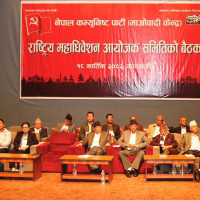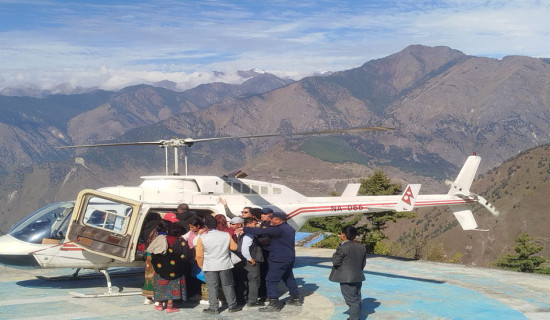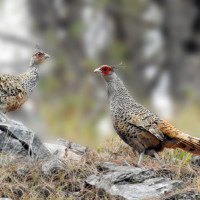- Tuesday, 4 November 2025
Golden Monitor Lizard
In Kapilvastu district, especially during the monsoon season, you can find various rare animals, local birds, and migratory birds. I visited the area on August 27, 2023, for wildlife photography and talked to locals in places like Jagdishpur Wetland, Niglihawa, Gotihawa, Akbarpur and Labani areas seeking information about rare animals and birds, with a special focus on the Golden Monitor Lizard.
Following the locals' advice, I began my search for the reptile. The first time I spotted it was near the Jagdishpur wetland, specifically by a small pond on the south side. Locals refer to the plant in that area as "Behaya." I tried to photograph the lizard, but it quickly hid in the bushes of Ipomoea carnea (subspecies fistulosa). Despite my wait for over 2 hours, I couldn't capture a photo. The next day, I saw the Golden Monitor Lizard in the Labani area pond. Once again, it hid in the bushes upon hearing the noise of my car, making it difficult for me to get a picture.

After realising that the Golden Monitor Lizard is quite shy, I started using binoculars to spot it from a distance, especially near the Ipomoea carnea bushes. In the Gotihawa area of Jagdishpur wetlands, I finally captured my first photo of the lizard feeding on dead domestic animals near a canal. I hid in a paddy field, but the photo wasn't perfect as it was inside the bush. I continued my search in the Sauraha Lake, where I successfully took good pictures of the reptile. During my 45-day stay in Kapilvastu, I spotted this reptile seven times near ponds, especially around Ipomoea carnea bushes.
One day, I discovered local children had killed a Golden Monitor Lizard near Jagdishpur Reservoir. They had used sticks and stones to kill the lizard, and it was thrown into the pond. I took some pictures of the dead lizard floating in the water. During my stay, I managed to photograph various rare animals and migratory birds, including local ones. Before heading to Kathmandu, I led a public awareness discussion with local residents, highlighting the significance of not harming these rare animals, with Bhagwati Singh of Jagadishpur. I highlighted that Golden Monitor Lizards don't pose a significant threat to humans and should be protected. I also learned that research is being conducted on these reptiles in the district.
The presence of Golden Monitor Lizards in Kapilvastu is due to the diverse ecology, including wetlands, ponds, lakes, canals, rivers, and agricultural areas. Jagdishpur Reservoir, a Ramsar Site, was studied, revealing a variety of reptile and amphibian species. The Golden Monitor Lizard, scientifically known as Vanus flavescens, is native to Nepal and is found in Terai protected areas, wetlands, and nearby forests.
This reptile is called "Sun Gohoro" in Nepal. Globally, there are 80 recognised species of monitor lizard, with the Golden Monitor Lizard being one of them. It's native to Nepal, India, Bangladesh, Pakistan, and Myanmar. Public awareness is crucial to protect these rare reptiles, as their population is decreasing due to a lack of awareness and killings.
Features
The body of the Golden Monitor Lizard has a dark brown colour on top and yellow on the bottom. It's about 0.45 metres long, with a tail of around 49 centimetres, and weighs between 4 and 5 kilograms. One can often spot it near water in bushes or forests. This lizard has subcorneal teeth and a distinctive crest of strong teeth. Its well-developed limbs have sharp, curved claws. Its long, thin, forked tongue helps it sense smells and locate prey. The snout is short and slightly convex, and it has an oblique nose slit. The tail is weakly compressed and arched, with smooth abdominal scales in 65 to 75 rows. It is a carnivore, eating insects, crustaceans, arachnids, myriapods, mollusks, fish, amphibians, reptiles, birds, and even the flesh of dead domestic animals. Juveniles focus on invertebrates. It is a beautiful creature with a lifespan of 15 to 20 years.
They are unable to climb trees because their hind feet have small toes. They primarily reside in floodplains, wetlands, forests, human settlements, and agricultural areas. These lizards lay 8 to 30 eggs, depending on their size. The eggs weigh about 11.4 grammes, and it takes 8 to 9 months for them to hatch. They lay their eggs in rivers, ponds, canals, or holes on the banks, especially around termite mounds. Both male and female Golden Monitor Lizards take turns taking care of and feeding their young. Once the babies grow up, they move to find their own place.
Threats
In the Jagdishpur area of Kapilvastu, locals use things like sticks, stones, and farming tools to harm and kill Golden Monitor Lizards. People also target them for their skin and meat. The use of too many pesticides in fields is causing their numbers to drop, and their homes are being destroyed. In fish farming ponds, they are accidentally caught in nets and are often killed as they eat fish.
The population of these lizards has decreased so much that the IUCN has put them on the Red List, and they are also listed in the CITES Appendix, which means they are at risk globally. Dr. Hem Sagar Baral, an ecologist, says that the National Parks and Wildlife Conservation Act 2029 strictly protects this species. Only three reptiles, including the Golden Monitor Lizard, are on this strict protection list.
The habitat considered best for these lizards in Nepal is Lumbini Farmscape (Kapilvastu, Rupandehi, and Nawalparasi). Sadly, they are in danger of disappearing because of hunting, illegal trading, and losing their homes. The government has laws to protect these reptiles. According to the National Wildlife and Wildlife Protection Act, 2029, if someone harms or kills these protected wild animals, they can be fined from Rs. 100,000 to Rs. 500,000, face imprisonment from one year to ten years, or both.
(The author is a wildlife photographer. Photos used in this article are by the author himself.)









-original-thumb.jpg)






